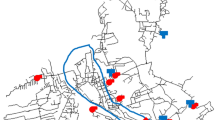Abstract
A proper division of a Water Distribution System (WDS) into District Metered Areas (DMAs) provides important management benefits particularly with regard to leakage detection through water balances, control and optimization of pressure so as to reduce leakage, implementation of monitoring, warning and emergency acting systems against accidental or intentional water contamination. This paper presents a new methodology that combines a suitable modularity-based algorithm for the automated creation of DMA boundaries and convincing practical criteria for the DMA design. A further plus of the proposed methodology is its ability to identify many technically feasible solutions that can be subsequently economically assessed. The successful applications of the proposed methodology to a real case study, already tested by other authors, has proven its effectiveness for the DMA design in existing water distribution systems.



Similar content being viewed by others
References
Alvisi S, Franchini M (2014) A heuristic procedure for the automatic creation of district metered areas in water distribution systems. Urban Water J 11(2):137–159
Awumah K, Goulter I, Bhatt SK (1991) Entropy-based redundancy measures in water-distribution networks. J Hydraul Eng 117(5):595–614
AWWA Water Loss Control Committee (2003) Applying worldwide BMPs in water loss control. J Am Water Works Assoc 95(8):65–71
Clauset A, Newman MEJ, Moore C (2004) Finding community structure in very large networks. Phys Rev E 70(6):066111
Courtois PJ (1985) On time and space decomposition of complex structures. Commun ACM 28(6):590–603
Creaco E, Franchini M, Todini E (2016) The combined use of resilience and loop diameter uniformity as a good indirect measure of network reliability. Urban Water J 13(2):167–181
Deuerlein JW (2008) Decomposition model of a general water supply network graph. J Hydraul Eng 134(6):822–832
Di Nardo A, Di Natale M (2011) A heuristic design support methodology based on graph theory for district metering of water supply networks. Eng Optim 43(2):193–211
Di Nardo A, Di Natale M, Santonastaso GF, Venticinque S (2011) Graph partitioning for automatic sectorization of a water distribution system. In: Savic D, Kapelan Z, Butler D (eds) Proceedings of computer and control in water industry CCWI 2011. University of Exeter, UK, pp 841–846
Di Nardo A, Di Natale M, Guida M, Musmarra D (2013a) Water network protection from intentional contamination by sectorization. Water Resour Manag 27:1837–1850. doi:10.1007/s11269-012-0133-y
Di Nardo A, Di Natale M, Santonastaso GF, Tzatchkov VG, Alcocer-Yamanaka VH (2013b) Water network sectorization based on graph theory and energy performance indices. J Water Resour Plann Manage 140(5):620–629
Di Nardo A, Di Natale M, Santonastaso GF, Venticinque S (2013c) An automated tool for smart water network partitioning. Water Resour Manag 27(13):4493–4508
Diao K, Zhou Y, Rauch W (2013) Automated creation of district metered area boundaries in water distribution systems. J Water Resour Plann Manage 139(2):184–190
Farley M (2001) Leakage monitoring and control. Leakage management and control: a best practice training manual. World Health Organization, Geneva, pp 58–98
Farmani R, Walters G, Savic D (2006) Evolutionary multi-objective optimization of the design and operation of water distribution network: total cost vs. reliability vs. water quality. J Hydroinf 8(3):165–179
Ferrari G, Savic D, Becciu G (2014) Graph theoretic approach and sound engineering principles for design of district metered areas. J Water Resour Plann Manage 140(12), 04014036
Giustolisi O, Ridolfi L (2014) New modularity-based approach to segmentation of water distribution networks. J Hydraul Eng 140(10), 04014049
Grayman WM, Murray R, Savic DA (2009) Effects of redesign of water systems for security and water quality factors. World Environmental and Water Resources Congress 2009, ASCE, Great Rivers, 504–514
Herrera M, Izquierdo J, Pérez-García R, Montalvo I (2012) Multi-agent adaptive boosting on semi-supervised water supply clusters. Adv Eng Softw 50:131–136
Izquierdo J, Herrera M, Montalvo I, Pérez-García R (2011) Division of water supply systems into district metered areas using a multi-agent based approach. Communications in Computer and Information Science, Springer, Berlin, pp 167–180
Morrison J, Tooms S, Rogers D (2007) District metered areas guidance notes, international water association water loss task force. IWA Publishing, London
Newman MEJ (2004a) Fast algorithm for detecting community structure in networks. Phys Rev E 69, 066133
Newman MEJ (2004b) Analysis of weighted networks. Phys Rev E 70, 056131
Newman MEJ, Girvan M (2004) Finding and evaluating community structure in networks. Phys Rev E 69(2), 026113
Nicolini M, Zovatto L (2009) Optimal location and control of pressure reducing valves in water networks. J Water Resour Plann Manage 135(3):178–187
Perelman L, Ostfeld A (2011) Topological clustering for water distribution systems analysis. Environ Model Softw 26(7):969–972
Salingaros NA (2001) Remarks on a city’s composition. J Des Res, 4(1)
Swamee PK, Sharma AK (1990) Decomposition of large water distribution systems. J Environ Eng 116(2):269–283
Thornton J (2003) Managing leakage by managing pressure: a practical approach. Water 21 6(1):43–44
Todini E (2000) Looped water distribution networks design using a resilience index based heuristic approach. Urban Water 2(3):115–122
Tsakiris G, Spiliotis M (2012) Applying resilience indices for assessing the reliability of water distribution systems. Water Utility J 3:19–27
Tzatchkov VG, Alcocer-Yamanaka VH, Bourguett-Ortız V (2006) Graph theory based algorithms for water distribution network sectorization projects. Proc., 8th Annual Water Distribution Systems Analysis Symp, ASCE, Reston, pp 1–15
Zhu Z, Wang C, Ma L, Pan Y, Ding Z (2008) Scalable community discovery of large networks. 9th International Conference on Web-Age Information Management, 381–388
Acknowledgments
The authors acknowledge Prof. Wolfgang Rauch who provided a useful guidance to this research, and thank Dr. Stefano Alvisi and Prof. Marco Franchini who kindly provided the data of the WDS used in this study. The authors thanks the anonymous reviewers for their highly appreciated criticisms and suggestions.
Author information
Authors and Affiliations
Corresponding author
Rights and permissions
About this article
Cite this article
Ciaponi, C., Murari, E. & Todeschini, S. Modularity-Based Procedure for Partitioning Water Distribution Systems into Independent Districts. Water Resour Manage 30, 2021–2036 (2016). https://doi.org/10.1007/s11269-016-1266-1
Received:
Accepted:
Published:
Issue Date:
DOI: https://doi.org/10.1007/s11269-016-1266-1




